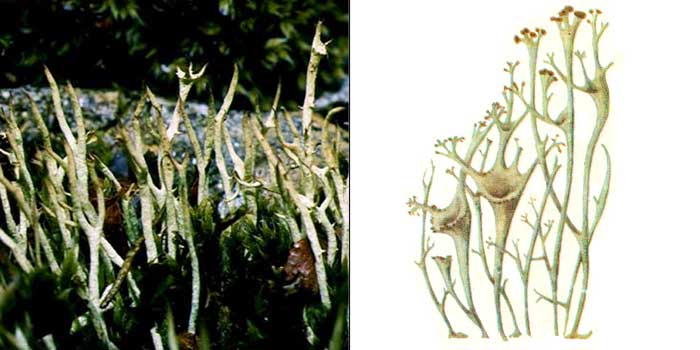SECONDARY METABOLITES CONTENT IN PINE FORESTS LICHENS OF CENTRAL YAKUTIA
Abstract
The studies were identified secondary metabolites of fruticoses lichens Cladonia amaurocraea, C.arbuscula, C.stellaris, C. rangiferina and Flavocetraria cucullata, grows in the pine forests of Central Yakutia, which were identified as lichen acid (Dibenzofuranes, Depsides, and α-Methylene-γ-lactones). It was shown that the content of lichens acid in thalli of lichens depend on the pine forest type, from which they were selected. The highest content of usnic acid in all studied lichens, as well as content lichesterinic, protolichesterinic acids in F. cucullata thalli, was observed in samples taken in the lichen-cowberry, bearberry-cowberry-lichen and crowberry-cowberry-lichen pine forests. At the same time, the content perlatolic acid, orcinol depsid and atranorin on the contrary higher in the samples C. stellaris C. amaurocraea and C. rangiferina, selected in the lichen-cowberry pine with larch admixture. Is assumed that the different contents of secondary metabolites in lichens growing in the studied types of Central Yakutia forest communities, may be due to the influence of abiotic environmental factors (light, temperature, humidity), and competition from other plant species.Downloads
Metrics
References
Бураева Л.Б., Николаева М.Г., Пожарицкая О.Н., Дугарова Г.О., Николаев С.М., Асеева Т.А. Радиопротекторное действие растительного препарата «Кладосент» при острой лучевой болезни у белых крыс // Растительные ресурсы. 1998. №1. С. 77–81.
Кершенгольц Б.М., Журавская А.Н., Хлебный Е.С., Шеин А.А., Филиппова Г.В., Шашурин М.М., Аньшакова В.В. Биопрепараты из природного арктического биосырья в сохранении здоровья населения в условиях изменений климата // Экология человека. 2010. №3. С. 8–15.
Аньшакова В.В. Биотехнологическая механохимическая переработка лишайников рода Cladonia. М., 2013. 116 с.
Равинская А.П., Вайнштейн Е.А. Влияние некоторых экологических факторов на содержание лишайниковых веществ // Экология. 1975. №3. C. 82–85.
Rundel P.W. Ecological role of secondary lichen substances // Biochemical Systematics and Ecology. 1978. Vol. 6. Pp. 157–170.
Уткин А.И. Леса Центральной Якутии. М., 1965. 208 с.
Тимофеев П.А., Исаев А.П., Щербаков И.П. Леса среднетаежной подзоны Якутии. Якутск, 1994. 140 с.
Колобкова М.В. Листоватые и кустистые лишайники окрестностей города Якутска // Биологические проблемы севера. Якутск, 1986. С. 46–47.
Huneck S., Yoshimura I. Identification of lichen substances. Springer-Verlag Berlin Heidelberg, 1996. 493 p.
Yoshimurat I., Kinoshita Y., Yainumoloi Y., Huneck S., Yamada Y. Analysis of Secondary Metabolites from Lichen by High Performance Liquid Chromatography with a Photodiode Array Detector // Phytochemical analysis. 1994. Vol. 5. Pp. 197–205.
Сильверстейн Р., Вебстер Ф., Кимл Д. Спектрометрическая идентификация органических соединений. М., 2014. 557 с.
Lawrey J.D. Biological Role of Lichen Substances // The Bryologist. 1986. Vol. 89. Pp. 111–122.


This work is licensed under a Creative Commons Attribution 4.0 International License.
The authors, which are published in this journal, agree to the following conditions:
1. Authors retain the copyright to the work and transfer to the journal the right of the first publication along with the work, at the same time licensing it under the terms of the Creative Commons Attribution License, which allows others to distribute this work with the obligatory indication of the authorship of this work and a link to the original publication in this journal .
2. The authors retain the right to enter into separate, additional contractual agreements for the non-exclusive distribution of the version of the work published by this journal (for example, to place it in the university depository or to publish it in a book), with reference to the original publication in this journal.
3. Authors are allowed to post their work on the Internet (for example, in a university repository or on their personal website) before and during the review process of this journal, as this may lead to a productive discussion, as well as more links to this published work.











